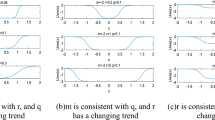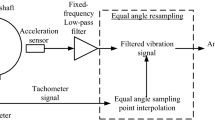Abstract
Fault feature extraction of the rolling bearing under strong background noise is always a difficult problem in bearing fault diagnosis. At present, most of the research focuses on weak signal extraction under Gaussian white noise and has certain practical significance. However, the noise in engineering is often complex and changeable, Gaussian white noise cannot fully simulate the actual strong background noise. Poisson white noise is a type of typical non-Gaussian noise, which widely exists in complex mechanical impact. It is of great significance to study the weak fault feature extraction of a faulty bearing under this type of noise. At the same time, variable speed conditions occupy most rotating machinery speed conditions. Non-stationary vibration signals make it difficult to extract fault features, and the frequency spectrum ambiguity will occur because of speed fluctuation. To solve the above problems, a method of weak feature extraction of a faulty bearing based on computed order analysis (COA) and adaptive stochastic resonance (SR) is proposed. Firstly, by numerical simulation, the non-stationary fault characteristic signal corrupted with strong Poisson noise is transformed into a stationary signal in the angle domain by COA. Secondly, the influence of the parameters of the pulse arrival rate and noise intensity of Poisson white noise on the optimal SR response in the angle domain are studied, and the influence of the parameters of Poisson white noise on the fault feature extraction is given. Then, adaptive SR method is used to extract and enhance fault feature information. Finally, the effectiveness of this method in weak fault characteristic signal extraction under strong Poisson noise is verified by experiments. Numerical simulation and experimental results verify the effectiveness of the proposed method in bearing fault diagnosis under strong Poisson noise and variable speed conditions.
Similar content being viewed by others
References
Z. Liu and L. Zhang, A review of failure modes, condition monitoring and fault diagnosis methods for large-scale wind turbine bearings, Measurement, 149 (2020) 107002.
B. Li, M. Y. Chow, Y. Tipsuwan and J. C. Hung, Neural-network-based motor rolling bearing fault diagnosis, IEEE Trans. Ind. Electron., 47(5) (2000) 1060–1069.
X. Lou and K. A. Loparo, Bearing fault diagnosis based on wavelet transform and fuzzy inference, Mech. Syst. Signal Process., 18(5) (2004) 1077–1095.
Y. Li, G. Cheng and C. Liu, Research on bearing fault diagnosis based on spectrum characteristics under strong noise interference, Measurement, 169 (2021) 108509.
J. Yang, C. Wu, Z. Shan, H. Liu and C. Yang, Extraction and enhancement of unknown bearing fault feature in the strong noise under variable speed conditions, Meas. Sci. Technol., 32(10) (2021) 105021.
Q. Jiang, F. Chang and B. Sheng, Bearing fault classification based on convolutional neural network in noise environment, IEEE Access, 7 (2019) 69795–69807.
M. Grigoriu, Response of dynamic systems to Poisson white noise, J. Sound Vib., 195(3) (1996) 375–389.
M. Grigoriu, Dynamic systems with Poisson white noise, Nonlinear Dyn., 36(2) (2004) 255–266.
C. Klüppelberg and C. Kühn, Fractional Brownian motion as a weak limit of Poisson shot noise processes-with applications to finance, Stoch. Process. Their Appl., 113(2) (2004) 333–351.
M. Makitalo and A. Foi, Optimal inversion of the Anscombe transformation in low-count Poisson image denoising, IEEE Trans. Image Process., 20(1) (2010) 99–109.
W. Kumwilaisak, T. Piriyatharawet, P. Lasang and N. That-phithakkul, Image denoising with deep convolutional neural and multi-directional long short-term memory networks under Poisson noise environments, IEEE Access, 8 (2020) 86998–87010.
K. Bodduna and J. Weickert, Poisson noise removal using multi-frame 3D block matching, 2019 8th European Workshop on Visual Information Processing (EUVIP), Roma (2019) 58–63.
Z. Ren, B. Zhao, W. Xu, P. Han and Y. Jiao, A convolution based path integration method approach to the damped parametric pendulum under different random noise excitations, Mech. Syst. Signal Process., 157 (2021) 107700.
M. He, W. Xu, Z. Sun and L. Du, Characterization of stochastic resonance in a bistable system with Poisson white noise using statistical complexity measures, Commun. Nonlinear Sci., 28(1–3) (2015) 39–49.
D. Huang, J. Yang, D. Zhou, G. Litak and H. Liu, Influence of Poisson white noise on the response statistics of nonlinear system and its applications to bearing fault diagnosis, J. Comput. Nonlinear Dyn., 14(3) (2019) 031010.
Y. Chang, Y. Wang, T. Liu and Z. J. Wang, Fault diagnosis of a mine hoist using PCA and SVM techniques, J. China Univ. Min. Technol., 18(3) (2008) 327–331.
Y. Kim, J. Park, K. Na, H. Yuan, B. D. Youn and C. Kang, Phase-based time domain averaging (PTDA) for fault detection of a gearbox in an industrial robot using vibration signals, Mech. Syst. Signal Process., 138 (2020) 106544.
Z. Feng, M. Liang and F. Chu, Recent advances in time-frequency analysis methods for machinery fault diagnosis: a review with application examples, Mech. Syst. Signal Process., 38 (2013) 165–205.
X. Zhang, Z. Liu, J. Wang and J. Wang, Time-frequency analysis for bearing fault diagnosis using multiple Q-factor Gabor wavelets, ISA Trans., 87 (2019) 225–234.
G. Dong and J. Chen, Noise resistant time frequency analysis and application in fault diagnosis of rolling element bearings, Mech. Syst. Signal Process., 33 (2012) 212–236.
J. Shi, M. Liang, D. S. Necsulescu and Y. Guan, Generalized stepwise demodulation transform and synchrosqueezing for time-frequency analysis and bearing fault diagnosis, J. Sound Vib., 368 (2016) 202–222.
G. Yu, A concentrated time-frequency analysis tool for bearing fault diagnosis, IEEE Trans. Instrum. Meas., 69(2) (2019) 371–381.
S. Lu, Q. He and J. Zhao, Bearing fault diagnosis of a permanent magnet synchronous motor via a fast and online order analysis method in an embedded system, Mech. Syst. Signal Process., 113 (2018) 36–49.
A. Sapena-Bano, M. Pineda-Sanchez, R. Puche-Panadero, J. Perez-Cruz, J. Roger-Folch, M. Riera-Guasp and J. Martinez-Roman, Harmonic order tracking analysis: a novel method for fault diagnosis in induction machines, IEEE Trans. Energy Convers., 30(3) (2015) 833–841.
J. Cheng, Y. Yang and D. Yu, The envelope order spectrum based on generalized demodulation time-frequency analysis and its application to gear fault diagnosis, Mech. Syst. Signal Process., 24 (2010) 508–521.
R. Benzi, A. Sutera and A. Vulpiani, The mechanism of stochastic resonance, J. Phys. A Math. Theor., 14 (1981) L453.
S. Lu, Q. He and J. Wang, A review of stochastic resonance in rotating machine fault detection, Mech. Syst. Signal Process., 116 (2019) 230–260.
Z. Qiao, Y. Lei and N. Li, Applications of stochastic resonance to machinery fault detection: a review and tutorial, Mech. Syst. Signal Process., 122 (2019) 502–536.
C. Yang, J. Yang, D. Zhou, S. Zhang and G. Litak, Adaptive stochastic resonance in bistable system driven by noisy NLFM signal: phenomenon and application, Philos. Trans. Royal Soc. A, 379(2192) (2021) 20200239.
J. Zhang, D. Huang, J. Yang, H. Liu and X. Liu, Realizing the empirical mode decomposition by the adaptive stochastic resonance in a new periodical model and its application in bearing fault diagnosis, J. Mech. Sci. Technol., 31(10) (2017) 4599–4610.
J. Zhang, J. Yang, G. Litak and E. Hu, Feature extraction under bounded noise background and its application in low speed bearing fault diagnosis, J. Mech. Sci. Technol., 33(7) (2019) 3193–3204.
T. Wang, M. Liang, J. Li and W. Cheng, Rolling element bearing fault diagnosis via fault characteristic order (FCO) analysis, Mech. Syst. Signal Process., 45 (2014) 139–153.
J. Sun, B. Feng and W. Xu, Particle swarm optimization with particles having quantum behavior, Proceedings of the 2004 Congress on Evolutionary Computation, 1 (2004) 325–331.
Z. Feng, X. Chen and T. Wang, Time-varying demodulation analysis for rolling bearing fault diagnosis under variable speed conditions, J. Sound Vib., 400 (2017) 71–85.
Acknowledgments
This project is supported by the Major Special Basic Research Projects of Aeroengine and Gas Turbine (Grant No. 2017-IV-0008-0045), China.
Author information
Authors and Affiliations
Corresponding author
Additional information
Qiang Ma received the B.S. degree in Mechanical and Electrical Engineering from Hebei Institute of Architecture and Technology in 2002, and a Master’s degree in Industrial Engineering from Hebei University of Engineering in 2010. He is currently pursuing a Doctorate degree in the School of Mechanical Engineering of Tianjin University since 2018. He has been an Associate Professor of Mechanical Engineering at Hebei University of Engineering, Handan City, Hebei province, China. He has published more than 10 papers in journals sponsored by IEEE, SAGE, ASME and other academic institutions. His main research interests include R&D and manufacturing of mechanical and electrical equipment, intelligent monitoring and fault diagnosis of mechanical systems.
Shuqian Cao who received his Ph.D. in Dynamics and Control from Tianjin University, is currently a Professor of Mechanics in the School of Mechanical Engineering, Tianjin University. He is now the Director of Tianjin Key Laboratory of Nonlinear Dynamics and Control, Council Member of Chinese Society for Vibration Engineering (CSVE). His research effort is focused on machine and structure dynamics, especially on the theory and applications of nonlinear dynamics in rotary machines, covering the fields of aero-engines, gas turbines and combustion engines. He and his co-workers have published over 100 papers and 3 books.
Rights and permissions
About this article
Cite this article
Ma, Q., Cao, S., Gong, T. et al. Weak fault feature extraction of rolling bearing under strong poisson noise and variable speed conditions. J Mech Sci Technol 36, 5341–5351 (2022). https://doi.org/10.1007/s12206-022-1001-1
Received:
Revised:
Accepted:
Published:
Issue Date:
DOI: https://doi.org/10.1007/s12206-022-1001-1




